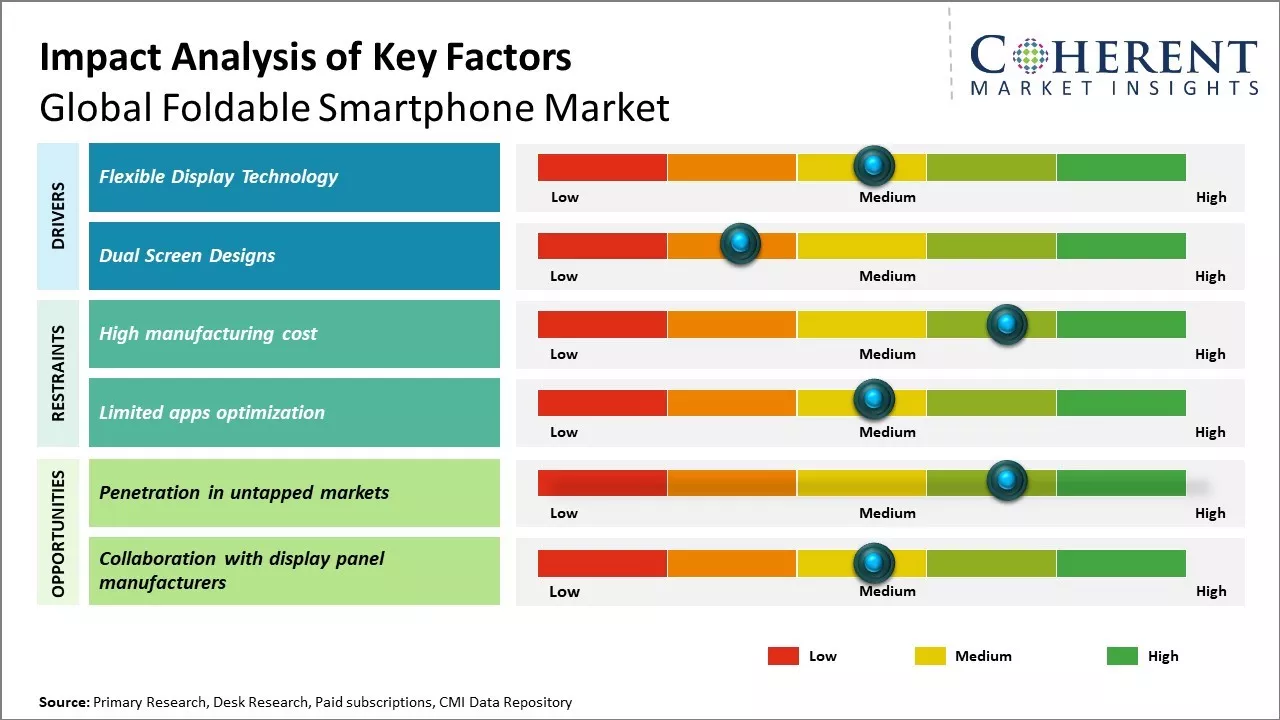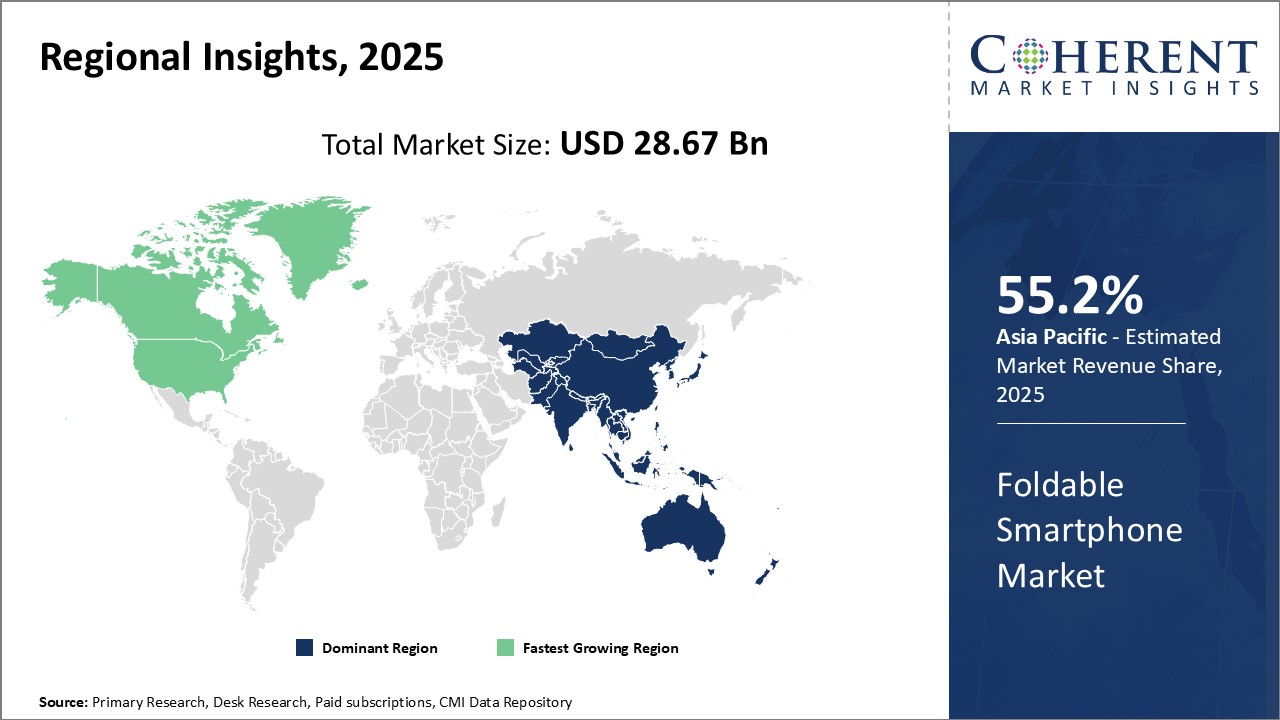Global foldable smartphone market is estimated to be valued at USD 28.67 Bn in 2025 and is expected to reach USD 102.79 Bn by 2032, exhibiting a compound annual growth rate (CAGR) of 20% from 2025 to 2032.
The global foldable smartphone market is rapidly expanding, fueled by significant R&D investments from major players driving innovation and adoption. Technological advancements are making foldable designs sleeker and more durable, with new form factors emerging beyond traditional styles.
The widespread availability of 5G connectivity is also a key driver, unlocking new use cases and boosting the demand for the immersive large-screen experiences these devices offer.

To learn more about this report, Download Free Sample

To learn more about this report, Download Free Sample
The foldable smartphone market is in a transitional phase. AI integration is becoming a crucial differentiator that can drive future growth.
|
Current Events |
Description and its impact |
|
Global Semiconductor Supply Chain Disruptions
|
|
|
U.S.-China Tech Trade War Escalation |
|
Uncover macros and micros vetted on 75+ parameters: Get instant access to report
The advent of flexible display technology has revolutionized smartphone design, enabling foldable models that offer expanded screen real estate. Unlike rigid glass, these displays can bend without damage, exemplified by devices like Samsung's Galaxy Fold. This functionality enhances multimedia and multitasking in a portable form factor, primarily driven by thin, lightweight OLED panels.
For instance, in August 2022, Xiaomi launched the MIX Fold 2, a foldable smartphone featuring a Qualcomm Snapdragon 8+ Gen 1 chipset and a slim 5.4 mm unfolded design, showcasing Xiaomi's proprietary micro waterdrop hinge.
Beyond fully foldable phones, some companies offer dual-screen designs, like the LG Velvet Dual Screen and Microsoft Surface Duo, which use two separate screens connected by a hinge to expand display area. While not as sleek as true foldables, these are generally more affordable and provide similar multitasking benefits, appealing to users seeking versatility.
The penetration in untapped markets can offer opportunities for global foldable smartphone market growth. In Latin America, Africa, the Middle East, and South Asia, foldable smartphones are not popular yet. As infrastructure and capabilities continue developing in these areas, more consumers will be able to access and afford innovative form factors like foldable devices.
As the affordability of these devices increases through competition and more accessible price points, foldable smartphones may appeal to previously untapped consumer segments, particularly in emerging regions. Manufacturers that strategically target these regions can capture early adopters and build lasting brand loyalty.
Among functionality type, inward fold segment is estimated to contribute the highest market share of 57.8% in 2025. Devices that fold inward are generally more protective of the display as it folds into the interior of the device rather than exposing it outward. This portability makes inward folding phones highly suitable for travelers and professionals who are constantly on-the-go.
The protective quality of inward folding attracts consumers concerned about display damage. Device makers have also focused heavily on refining the hinge and locking mechanisms for inward folding phones to feel sturdy and provide the impression of a premium product. Hinges have become increasingly resilient to withstand thousands of open-and-close cycles without flexing.
By sales channel, online segment is estimated to contribute the highest market share of 64.4% in 2025, due to the newness of foldable technology and consumers' tendency to research new devices online first before making purchasing decision. The dominance of online sales channels helps build awareness and reviews for foldable smartphones, which can then instill confidence among mainstream consumers and encourage them to consider adopting these innovative devices in the future.
Online retail provides a convenient way for consumers to easily compare foldable phone models, specifications, reviews and price points all in one place. This level of research ability and transparency plays to the sophistication of early foldable phone adopters. It also allows brands to promote pre-order deals and launch exclusives that incentivize purchases through their own websites or affiliate online channels. Due to advancements in technology, more options will become available in brick-and-mortar stores as well.

To learn more about this report, Download Free Sample
Asia Pacific region, particularly China, currently dominates the global foldable smartphone market with estimated market share of 55.2% in 2025. Increasing number of domestic Chinese brands such as Huawei, Oppo and Vivo are investing in foldable smartphone research.
This has allowed these brands to rapidly launch affordable mass market models, unlike the expensive niche devices previously only offered by Samsung. The intensely competitive smartphone landscape in China is encouraging constant innovation among domestic players.
The North America region is poised to be the fastest growing market for foldable smartphones. Major technology companies such as Samsung, Motorola, and Google have established strong research and development centers as well as manufacturing facilities in countries like the U.S. This allows these companies to closely monitor market trends and design foldable smartphones as per the preferences of North American consumers.
Rising disposable incomes in the region translates to a willingness to pay premium prices for innovative new form factors like foldable screens. Carriers also actively promote new device launches through subsidies and installment plans, making the latest foldable phones affordable and driving sales volumes.
The U.S. foldable smartphone market is growing due to tech advancements and consumer interest, though widespread adoption relies on improved durability and affordability. Manufacturers like Samsung, with its iterative Galaxy Z series, are actively addressing these needs, signaling continued growth in this key market.
The India smartphone market, though experiencing a recent dip in shipments in Q1 2025 due to softer consumer demand, continues to be driven by 5G expansion and a growing consumer preference for more advanced and premium devices.
Despite a slight volume decline, the market is seeing value growth, especially in higher-priced segments, as buyers increasingly seek feature-rich phones, including those with AI capabilities. Brands are strategically leveraging both online and physical retail channels, and local manufacturing is further strengthening India's role in the global smartphone supply chain.
| Report Coverage | Details | ||
|---|---|---|---|
| Base Year: | 2024 | Market Size in 2025: | USD 28.67 Bn |
| Historical Data for: | 2020 To 2024 | Forecast Period: | 2025 To 2032 |
| Forecast Period 2025 to 2032 CAGR: | 20% | 2032 Value Projection: | USD 102.79 Bn |
| Geographies covered: |
|
||
| Segments covered: |
|
||
| Companies covered: |
Samsung Electronics Co., Ltd., Huawei Technologies Co., Ltd., TCL Communication Technology Holdings Limited, Xiaomi Corporation, OPPO Electronics Corporation, Lenovo Group Ltd., Royole Corporation, ZTE Corporation, Microsoft Corporation, Motorola Mobility LLC, Kyocera Corporation, AsusTek Computer Inc., Energizer Holdings, Inc., Tecno Mobile Limited, DOOV (Shenzhen Doov Technology Co., Ltd.), HP Inc., Google LLC, Apple Inc., Meizu Technology Co., Ltd., Nubia Technology Co., Ltd. |
||
| Growth Drivers: |
|
||
| Restraints & Challenges: |
|
||
Uncover macros and micros vetted on 75+ parameters: Get instant access to report
*Definition: Global foldable smartphone market caters to smartphones that have a flexible display which allows the device's screen to bend and fold, increasing its screen size. These innovative phones can transform from a smartphone into a small tablet by unfolding the device. Major brands like Samsung, Huawei, and Motorola have launched foldable phones in this burgeoning market. With flexible AMOLED displays and dynamic form factors, foldable smartphones promise enhanced screen real estate and portability. However, their high prices and early adoption risks remain.
Share
Share
About Author
Monica Shevgan has 9+ years of experience in market research and business consulting driving client-centric product delivery of the Information and Communication Technology (ICT) team, enhancing client experiences, and shaping business strategy for optimal outcomes. Passionate about client success.
Missing comfort of reading report in your local language? Find your preferred language :
Transform your Strategy with Exclusive Trending Reports :
Frequently Asked Questions
Joining thousands of companies around the world committed to making the Excellent Business Solutions.
View All Our Clients